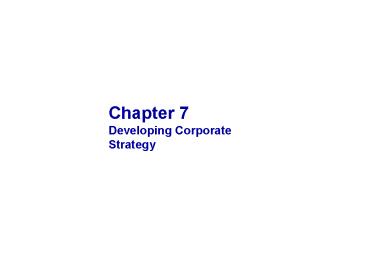Chapter 7 Developing Corporate Strategy - PowerPoint PPT Presentation
1 / 26
Title:
Chapter 7 Developing Corporate Strategy
Description:
Chapter 7 Developing Corporate Strategy OBJECTIVES DIVERSIFICATION THREE ... Latin America, Africa & Canada . 40.00 26.00 25.00 9.00 Sheet3. ... Latin America, Africa ... – PowerPoint PPT presentation
Number of Views:785
Avg rating:3.0/5.0
Title: Chapter 7 Developing Corporate Strategy
1
Chapter 7Developing Corporate Strategy
2
OBJECTIVES
1
Define corporate strategy
2
Understand the roles of economies of scope and
revenue-enhancement synergy in corporate strategy
3
Explain the different forms of diversification
4
Understand when it makes sense for a firm to own
a particular business
5
Describe the relationship between corporate
strategy and competitive advantage
6
Explain the corporate strategy implications of
the stable and dynamic perspectives
3
DIVERSIFICATION
Diversification process
Types of businesses
Company
Heavy reliance on acquisition
Many seemingly un-related businesses
Primarily organic
Many businesses clustered in a few related
industries
Product extensions/new product lines
Few related product lines
MITY
4
THREE CORPORATE STRATEGY DECISIONS THAT ARISE
WHEN MAKING ENTRY/EXIT DECISIONS
5
DIVERSIFICATION PROFILES
7
6
DIVERSIFICATION PROFILES (Continued)
7
7
DIVERSIFICATION PROFILES (Continued)
7
8
EVOLUTION OF DIVERSIFICATION
- Vertical Integratione.g. General Motors began
operating steel plants to ensure supply of raw
materials - Expansion into related businessese.g. Dupont
moved from gunpowder making onto dynamite,
nitro-glycerine, guncotton, and smokeless power - Rapid consolidation at turn of the century led to
antitrust lawse.g. Standard Oil - Wave of conglomerations in 1960s Unrelated
acquisitions expanded the size of companies
Widespread use of portfolio planning (e.g. BCG
Matrix see my research) - Corporate Raiders in 1980s broke up many
conglomerates - New wave of acquisitions in 1990s and 2000s
Mainly related acquisitions
9
A BRIEF HISTORY AND GENEOLOGY OF A CONGLOMERATE
ITT
2
1995 ITT Industries (auto, defense electric
systems, fluid-control) The Surviving ITT
1940 Electronics businesses
1925 telecom equipment mfr.
1920 International Telephone and Telegraph
1995 ITT Hartford (financial services) Now
Hartford Financial Services
1960 Enters auto parts industry
1969 Buys Hartford Insurance
10
MUST DETERMINE VALUE CREATION
19
Geographic diversification
Horizontaldiversification
Verticaldiversification
11
SOURCES OF VALUE FROM DIVERSIFICATION/EXPANSION
12
DIVERSIFICATION DOES NOT NECESSARILY CREATE VALUE
Non-value generating
Value generating
Revenue
- No cross-sell opportunities
- Revenue enhancement
Profit
- Dis-economies of scope
- Economic of scope
Value
Costs
Valuation of profit
- No perceived value logic
- Investor-perceived quality
13
EXAMPLE OF POOR ECONOMIC LOGIC
- In 1990s, Diversified from long-distance
telephone services into wireless cell phone
service and cable TV - In 2002, decided to split thecompany apart
14
DIVERSIFICATION IS DIFFICULT TO MANAGE
15
OPPORTUNUTIES TO EXPLOIT POTENTIAL ECONOMIES OF
SCOPE
Fit among parent-subsidiary resources
Fit of parent-subsidiary dominant logic
What is a dominant logic?
16
OTHER REASONS TO DIVERSIFY
More efficient for investors to diversify
themselves
Rarely results in higher share- holder value or
margins
Acquisition motivated by executive pay - a
bigger company usually impliesa bigger pay check
-rarely creates value
17
FORMS AND SCOPE OF DIVERSIFICATION
Wal-Martexpanded intoEurope
Geographic
- Horizontal
- From one market segment to another
- From one industry to another
Coke andPepsi expandedinto water
Pulte HomesInc. created Pulte Mortgage LLC)
Vertical
18
PROFIT POOLS
Profit pool analysis helps identify opportunities
19
WHO SHOULD OWN THE BUSINESS?
Two key questions
?
20
COMPETITIVE ADVANTAGE
Resources
Implementation
Arenas
Organi-zationalstructure
Specialized
General
Systems
Processes
21
MASCO CORPORATION
Independent unattractive
Combined profitable
Homedepot
Home depot
Manu-facturing design and Marketing
Lowes
Lowes
22
CORPORATE OWNERSHIP IN A DYNAMIC CONTEXT
- Economies of scope
- Revenue enhancement
- In dynamic markets, diversification can hinder
competitiveness - This is why Adaptec, Palm, and 3Com spun off
businesses
- Nimbleness
- Response time
23
CORPORATE STRATEGY IN STABLE AND DYNAMIC CONTEXTS
24
HOW WOULD YOU DO THAT?
Walt Disney wants to enter more mature film
entertainment (e.g., Kill Bill)
Pros
Cons
What are Walt Disneys strategic options?
25
SUMMARY
26
EXERCISES
- Identify the vertical, horizontal and
geographical scope of MGM-Mirage of your choice.
How similar are the resource requirements (how
related is the firm)? Determine if there is a
dominant logic connecting the businesses. - Design a future corporate strategy for MGM-Mirage.































